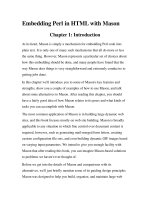Chapter 1 v7 01
Bạn đang xem bản rút gọn của tài liệu. Xem và tải ngay bản đầy đủ của tài liệu tại đây (4.32 MB, 84 trang )
Lai NGUYEN
Research & Interests
â1996-2016, J.F Kurose and K.W. Ross
ã Distributed systems: Analysis, optimization, and control of
systems with limited communication.
• Communication networks and protocols: Network
architecture, routing algorithms, protocols, applications, and
services. Network design, measurement, analysis, optimization,
and management.
▪ Areas of specialty
• Networked dynamic systems, distributed cooperative control, network
routing, constrained communication protocols, water systems.
▪ Contact
• Office: Faculty of Computer Science and Engineering
▪ Block A3, Ho Chi Minh City University of Technology
• Email:
©1996-2016, J.F Kurose and K.W. Ross
Computer Networks
Lectured by:
Nguyen Le Duy Lai
()
Computer
Networking: A Top
Down Approach
7th Edition, Global Edition
Jim Kurose, Keith Ross
Pearson
April 2016
Introduction
1-2
Course details
Credits
3 (3.2.7)
Credits Hours
Total:
75
Lecture:
42
Exercise:
Lab:
©1996-2016, J.F Kurose and K.W. Ross
Evaluation
Assessment method
Midterm:
10%
Code
CO3003
Lab:
22
Assignments:
11
Assignments: Final exam:
30%
60%
Final exam: Multiple choice questions, ~ 90 minutes
Laboratory work is compulsory (No lab work = No assignment mark)
Prerequisites
Co-requisites
Undergraduate Programs Computer Science and Computer Engineering
Website
/>3
Course outline (1)
▪ Fundamental concepts in the design and
implementation of computer networks
â1996-2016, J.F Kurose and K.W. Ross
ã Protocols, standards, services and applications
• Introduction to network programming
• Basic network security
▪ The goals of the course are to build on basic
networking knowledge in providing …
• an understanding of the tradeoffs and existing
technology used in complex networked systems
• concrete experience of the challenges through a series
of lab exercises.
4
Course outline (2)
©1996-2016, J.F Kurose and K.W. Ross
▪ The topics to be covered include:
• Introduction to network architecture, OSI and TCP/IP
reference models.
• Common applications and application layer protocols: Web
(HTTP), DNS, E-mail (POP3, IMAP, SMTP), P2P, and CDN.
• Internet transport protocols (UDP and TCP)
• Issues related to routing and internetworking, Internet
addressing, routing protocols and Internet Protocol (IP).
• Network technologies, especially LAN technologies (Ethernet,
wireless networks and Bluetooth).
• Network-programming interface
• Network security
5
©1996-2016, J.F Kurose and K.W. Ross
Contents
▪
▪
▪
▪
▪
▪
▪
▪
▪
Computer Networks and the Internet
Application Layer
Transport Layer
The Network Layer: Data Plane
The Network Layer: Control Plane
The Link Layer and LANs
Wireless and Mobile Networks
Security in Computer Networks
Multimedia Networking
Introduction
2-6
References
▪ “Computer Networking: A Top Down Approach”,
Jim Kurose, Keith Ross, 7th Global Edition, Pearson,
2016.
©1996-2016, J.F Kurose and K.W. Ross
▪ “The Illustrated Network: How TCP/IP Works in
a Modern Network”, Walter Goralski, Second Edition,
Morgan Kaufman, 2017.
▪ “Computer Networks”, Andrew S. Tanenbaum, David J.
Wetherall, 5th Edition, Prentice Hall, 2012.
7
©1996-2016, J.F Kurose and K.W. Ross
Chapter 1
Introduction
Computer
Networking: A Top
Down Approach
7th Edition, Global Edition
Jim Kurose, Keith Ross
Pearson
April 2016
Introduction
1-8
©1996-2016, J.F Kurose and K.W. Ross
Chapter 1: introduction
our goal:
▪ get “feel” and
terminology
▪ more depth, detail
later in course
▪ approach:
• use Internet as
example
overview:
▪ what’s the Internet?
▪ what’s a protocol?
▪ network edge: hosts, access net,
physical media
▪ network core: packet/circuit
switching, Internet structure
▪ performance: loss, delay, throughput
▪ security
▪ protocol layers, service models
▪ history
Introduction
1-9
Chapter 1: roadmap
1.1 what is the Internet?
1.2 network edge
▪ end systems, access networks, links
1.3 network core
©1996-2016, J.F Kurose and K.W. Ross
▪ packet switching, circuit switching, network structure
1.4 delay, loss, throughput in networks
1.5 protocol layers, service models
1.6 networks under attack: security
1.7 history
Introduction
1-10
What’s the Internet: “nuts and bolts” view
▪ billions of connected
server
computing devices:
wireless
ã hosts = end systems
laptop
ã running network apps
smartphone
â1996-2016, J.F Kurose and K.W. Ross
PC
▪ communication links
• media: fiber, copper,
wireless
links
radio, satellite
wired
• transmission rate:
links
bandwidth
router
▪ packet switches: forward
packets (chunks of data)
• routers and switches
mobile network
global ISP
home
network
regional ISP
institutional
network
Introduction
1-11
“Fun” Internet-connected devices
Web-enabled toaster +
weather forecaster
©1996-2016, J.F Kurose and K.W. Ross
IP picture frame
/>
Slingbox: watch,
control cable TV remotely
Internet
refrigerator
Tweet-a-watt:
monitor energy use
sensorized,
bed
mattress
Internet phones
Introduction
1-12
What’s the Internet: “nuts and bolts” view
▪ Internet: “network of networks”
mobile network
• Interconnected ISPs
global ISP
▪ Protocols: control sending, receiving
of messages
• e.g., TCP, IP, HTTP, Skype, 802.11
©1996-2016, J.F Kurose and K.W. Ross
▪ Internet standards
home
network
regional ISP
• RFC: Request for comments
• IETF: Internet Engineering Task Force
institutional
network
Introduction
1-13
What’s the Internet: a service view
▪ infrastructure that provides
services to applications
ã Web, VoIP, email, games, ecommerce, social nets,
â1996-2016, J.F Kurose and K.W. Ross
▪ provides programming
interface to apps
mobile network
global ISP
home
network
regional ISP
• hooks that allow sending
and receiving app programs
to “connect” to Internet
• provides service options,
analogous to postal service
institutional
network
Introduction
1-14
©1996-2016, J.F Kurose and K.W. Ross
What’s a protocol?
human protocols:
network protocols:
▪ “what’s the time?”
▪ “I have a question”
▪ introductions
▪ machines rather than
humans
▪ all communication activity
in Internet governed by
protocols
… specific messages sent
… specific actions taken
when messages
received, or other
events
protocols define format, order of
messages sent and received
among network entities, and
actions taken on message
transmission, reception
Introduction
1-15
What’s a protocol?
a human protocol and a computer network protocol:
Hi
TCP connection
request
©1996-2016, J.F Kurose and K.W. Ross
Hi
TCP connection
response
Got the
time?
Get />
2:00
<file>
time
Q: other human protocols? A: ?
Introduction
1-16
Chapter 1: roadmap
1.1 what is the Internet?
1.2 network edge
▪ end systems, access networks, links
1.3 network core
©1996-2016, J.F Kurose and K.W. Ross
▪ packet switching, circuit switching, network structure
1.4 delay, loss, throughput in networks
1.5 protocol layers, service models
1.6 networks under attack: security
1.7 history
Introduction
1-17
A closer look at network structure:
▪ network edge
mobile network
• hosts: clients and servers
global ISP
ã servers often in data
centers
â1996-2016, J.F Kurose and K.W. Ross
▪ access to networks,
physical media
home
network
regional ISP
▪ wired, wireless
communication links
▪ network core
• interconnected routers
• network of networks
institutional
network
Introduction
1-18
Access networks and physical media
Q: How to connect end
systems to edge router?
©1996-2016, J.F Kurose and K.W. Ross
▪ residential access networks
▪ institutional access networks
(e.g., school, company)
▪ mobile access networks
keep in mind:
▪ bandwidth (bits per second bps) of access network?
▪ shared or dedicated?
Introduction
1-19
Access network: digital subscriber line (DSL)
central office
©1996-2016, J.F Kurose and K.W. Ross
DSL splitter
modem
voice, data transmitted
at different frequencies over
dedicated line to central office
telephone
network
DSLAM
ISP
DSL access
multiplexer
▪ use existing telephone line to central office DSLAM
• data over DSL phone line goes to Internet
• voice over DSL phone line goes to telephone network
▪ < 2.5Mbps upstream transmission rate (typically < 1Mbps)
▪ < 24Mbps downstream transmission rate (typically < 10Mbps)
Introduction
1-20
Access network: cable network
cable headend
…
©1996-2016, J.F Kurose and K.W. Ross
cable splitter
modem
V
I
D
E
O
V
I
D
E
O
V
I
D
E
O
V
I
D
E
O
V
I
D
E
O
V
I
D
E
O
D
A
T
A
D
A
T
A
C
O
N
T
R
O
L
1
2
3
4
5
6
7
8
9
Channels
frequency division multiplexing: different channels transmitted
in different frequency bands
Introduction
1-21
Access network: cable network
cable headend
…
cable splitter
modem
data and TV transmitted at different
©1996-2016, J.F Kurose and K.W. Ross
frequencies over shared cable
distribution network
CMTS
cable modem
termination system
ISP
▪ HFC: hybrid fiber coax
• asymmetric: up to 30Mbps downstream transmission rate,
2Mbps upstream transmission rate
▪ network of cable, fiber attaches homes to ISP router
• homes shared access network to cable headend
• unlike DSL, which has dedicated access to central office
Introduction
1-22
Access network: home network
wireless
devices
©1996-2016, J.F Kurose and K.W. Ross
to/from headend or
central office
often combined
in single box
cable or DSL modem
wireless access
point (54 Mbps)
router, firewall, NAT
wired Ethernet (1 Gbps)
Introduction
1-23
Enterprise access networks (Ethernet)
institutional link to
ISP (Internet)
©1996-2016, J.F Kurose and K.W. Ross
institutional router
Ethernet
switch
institutional mail,
web servers
▪ typically used in companies, universities, etc.
▪ 10 Mbps, 100 Mbps, 1 Gbps, 10 Gbps transmission rates
▪ today, end systems typically connect into Ethernet switch
Introduction
1-24
Wireless access networks
▪ shared wireless access network connects end system to router
• via base station aka “access point”
wide-area wireless access
wireless LANs:
©1996-2016, J.F Kurose and K.W. Ross
▪ within building (100 ft.)
▪ 802.11b/g/n/ac (Wi-Fi): transmission
rate 11/54/450/1000 Mbps
to Internet
▪ provided by telco (cellular)
operator, 10’s km
▪ between 1 and 10 Mbps
▪ 3G, 4G (LTE), 5G
to Internet
Introduction
1-25









